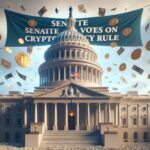In a surprising move that shook the cryptocurrency world, U.S. President Donald Trump announced a plan for a strategic crypto reserve during his recent address. This reserve aims to include prominent digital currencies like XRP, Cardano’s ADA, and Solana’s SOL, alongside the well-known Bitcoin (BTC) and Ethereum (ETH). The proposal, which has been part of Trump’s dialogue since launching his 2024 presidential campaign, positions the U.S. to create a stockpile of digital assets that could play a significant role in the nation’s economic strategy.
Following an executive order he signed shortly after taking office, which called for a working group to assess the formation of a digital asset reserve, Trump revealed that the team will gather for a summit this Friday. Market reactions to the announcement were swift, with cryptocurrencies like ADA and XRP experiencing jumps of up to 60%, while Bitcoin recovered above the ,000 mark.
“The crypto industry will achieve our goals if we work together,” said Brad Garlinghouse, CEO of Ripple Labs, emphasizing the collaborative spirit needed in the sector.
Industry experts are weighing in on the implications of a U.S. crypto reserve. Hunter Horsely, CEO of Bitwise, expressed a preference for focusing solely on Bitcoin as a primary reserve asset, citing its established reputation as a store of value. In contrast, others like Brian Armstrong from Coinbase are still considering the optimal approach to asset allocation within the reserve.
“This move signals recognition of cryptocurrencies’ value and contribution to the national economy,” noted Tracy Jin, COO of MEXC, highlighting the potential benefits for market stability and regulation.
However, not everyone agrees with the diverse asset approach. Some skeptics, like Peter Schiff, question the inclusion of assets like XRP, calling for a clearer rationale behind such decisions. As opinions continue to flow, the upcoming White House Crypto Summit promises to provide further clarity on how this strategic reserve might shape the future of the U.S. cryptocurrency landscape.

Trump’s Strategic Crypto Reserve Announcement
The recent announcement by U.S. President Donald Trump regarding the formation of a crypto strategic reserve has stirred significant interest and implications for both the crypto market and the broader economy. Here are the key points to consider:
- Formation of a Strategic Crypto Reserve:
- Trump proposed a national digital asset stockpile, officially moving forward with forming a strategic reserve.
- The reserve includes assets such as XRP, Cardano’s ADA, Solana’s SOL, bitcoin (BTC), and ether (ETH).
- Market Reactions:
- Immediate market impact saw ADA and XRP surge by up to 60% and bitcoin rise above ,000.
- Traders advised caution amid market volatility as details of the reserve are finalized.
- Industry Leaders’ Perspectives:
- Hunter Horsely emphasized that bitcoin should be the primary reserve asset due to its status as a store of value.
- Brad Garlinghouse highlighted the importance of collaboration in the crypto industry and welcomed the recognition of diverse assets.
- Brian Armstrong suggested a market cap weighted index could provide variety within the reserve but acknowledged bitcoin’s simplicity.
- Critics like Peter Schiff questioned the inclusion of other assets like XRP, arguing for a focus on bitcoin alone.
- Potential Long-Term Implications:
- The establishment of a U.S. crypto reserve could stabilize market volatility and lend legitimacy to crypto assets.
- May lead to clearer regulatory guidelines for cryptocurrencies, a long-sought goal from industry players.
- Historically, strategic reserves have influenced demand and prices for commodities, potentially foreshadowing similar effects on digital assets.
- Significance of Multi-Chain Assets:
- The announcement indicates a shift away from a bitcoin-only approach to recognizing the multi-dimensional potential of various cryptocurrencies.
- This could pave the way for advanced financial solutions and encourage broader adoption across sectors.
- Upcoming White House Crypto Summit:
- The planned summit on March 7 will gather representatives from the crypto industry and government, marking a significant step in formalizing the reserve.
- Industry leaders will likely influence the strategic reserve’s direction and implementation, impacting how cryptocurrencies integrate into the national economy.
Trump’s Strategic Crypto Reserve: A Game Changer or Another Hurdle?
The announcement from President Donald Trump regarding the establishment of a strategic crypto reserve has undeniably sent ripples throughout the cryptocurrency community. With the inclusion of assets like XRP, Cardano’s ADA, and Solana’s SOL, alongside bitcoin and ether, this initiative speaks volumes about an evolving landscape. On the surface, it seems like a monumental step towards mainstream adoption of cryptocurrencies, but a closer look reveals both bright spots and potential pitfalls.
Competitive Advantages: One of the most significant advantages of this strategic initiative is the perceived legitimization of a broader range of cryptocurrencies beyond just bitcoin. By acknowledging the value of multiple tokens, Trump potentially opens the gates for more diversified investment in the crypto sector. Industry leaders like Brad Garlinghouse, CEO of Ripple Labs, emphasize the strength in unity and the recognition of a multichain reality, which may foster collaboration across different blockchain technologies. This initiative could also lay the groundwork for clearer regulatory frameworks, crucial for attracting institutional investments and stabilizing the market. The potential for enhanced visibility and investor confidence in assets like ADA and SOL, known for their unique technological applications, makes this an exciting time for the industry.
Disadvantages and Challenges: However, the plan may face scrutiny, especially from purists who advocate for a more bitcoin-centric strategy. Noted economist Peter Schiff raises questions regarding the need for a reserve that includes assets like XRP, arguing it’s counterintuitive when considering the fixed-supply nature of bitcoin. Moreover, skepticism from industry experts, like Arthur Hayes from BitMEX, underscores a significant concern: if this initiative lacks congressional approval or financial backing, it risks becoming mere rhetoric. This hesitation can create uncertainty within the marketplace, prompting cautious traders to rethink their exposure to these assets. Additionally, there’s a potential backlash from the community for perceived favoritism toward certain coins, which could ignite debates on what constitutes a ‘valid’ crypto asset.
Implications for Different Stakeholders: For those engaged in regulatory frameworks and institutional investment, a structured U.S. crypto reserve offers a clearer path to legitimacy, potentially attracting major players hesitant to enter the volatile market. However, for everyday traders and smaller, less established assets, the favoring of certain coins over others may create disparities in market dynamics. This initiative could be a boon for innovative projects with tangible real-world applications, but it might stifle emerging or less popular cryptocurrencies that struggle for visibility and investment.
Overall, the implications of Trump’s strategic crypto reserve are vast and multifaceted. Whether it will serve as a stabilizing force or add layers of complication remains to be seen, but one thing is clear: the crypto world is poised for a debate on the future of digital finance as traditional economic strategies intertwine with blockchain innovation.

















